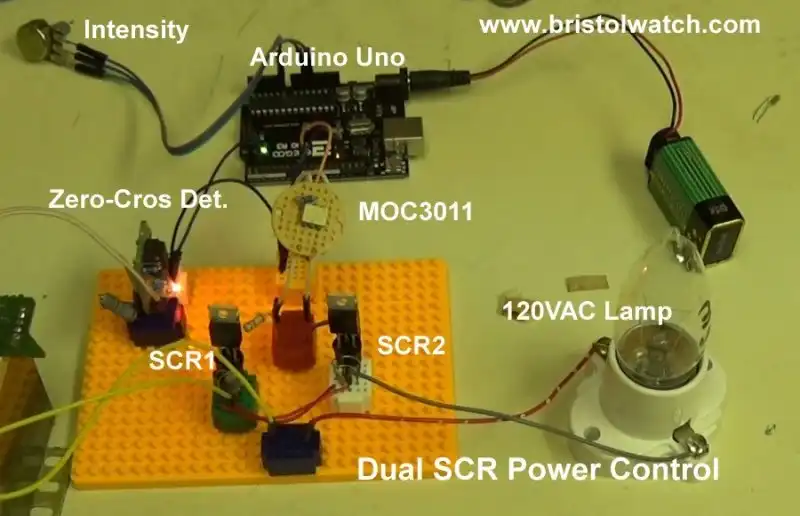
Fig. 1
Silicon Controlled Rectifiers Connected as a Power Triac
by Lewis Loflin
Silicon-controlled rectifier (SCRs) are used for high power AC switching. When used in pairs to simulate their Triac cousins they can switch higher power levels. This is because only one SCR is one at one time thus a lower duty cycle.
Fig. 1 shows the circuit I built and it works. I also found out what doesn't work.
They are also called Thyristors. For more on the properties of SCRs related to these circuits:
- Basic Triacs and SCRs
- Light Activated SCR Based Optocouplers Circuit Examples
- Silicon Controlled Rectifier Review and Circuits
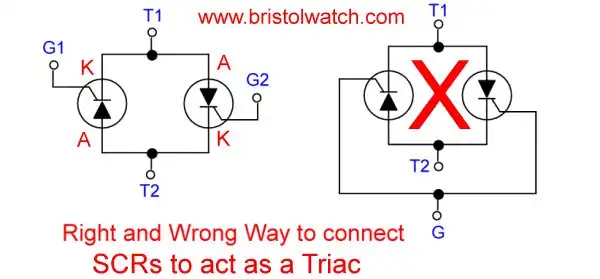
Fig. 2
Fig. 2 illustrates the right and wrong way to connect silicon-controlled rectifiers as Triacs. I built the circuit on the right that is presented across the web. It does not work with both SCRs on all the time.
The better way to view this is the left side where anode is tied to cathode. The two gates must be separate to be properly triggered as individual devices.
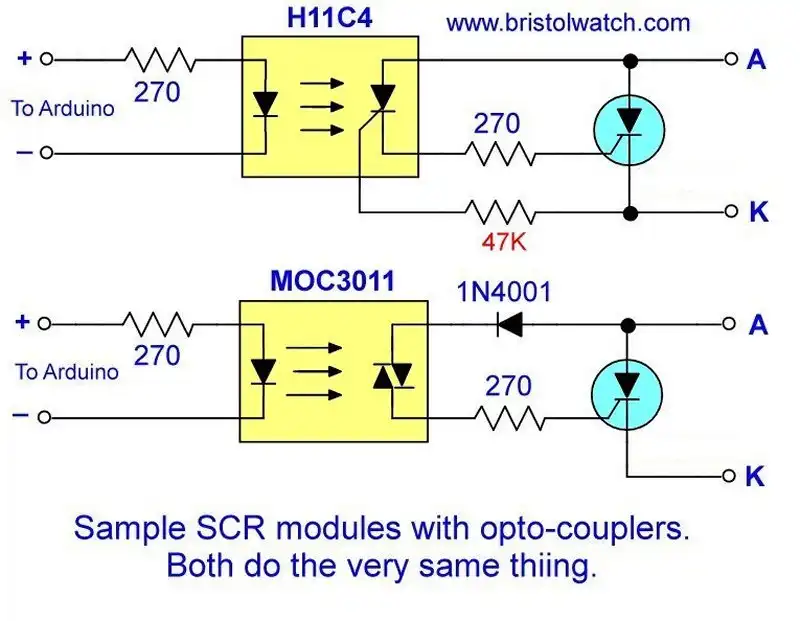
Fig. 3
The best option to trigger SCRs or Triacs is with opto-coupler as shown in Fig. 3.
The H11CX photo SCR opto-couplers are designed to the express purpose of triggering SCRs. The problem is many of these parts are hard to find today.
One can use the MOC30XX photo Triac opto-couplers with the addition of a diode in the gate circuit. My test show no practical difference in operation.
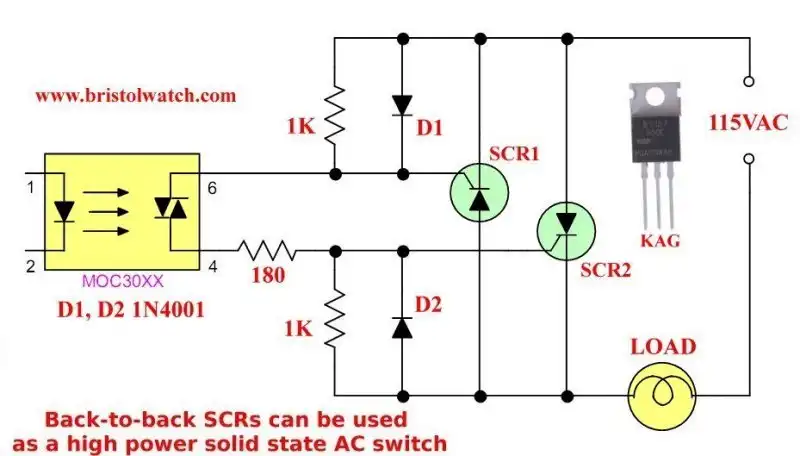
Fig. 4
Fig. 4 is the exact circuit diagram for the setup I built in Fig. 1.
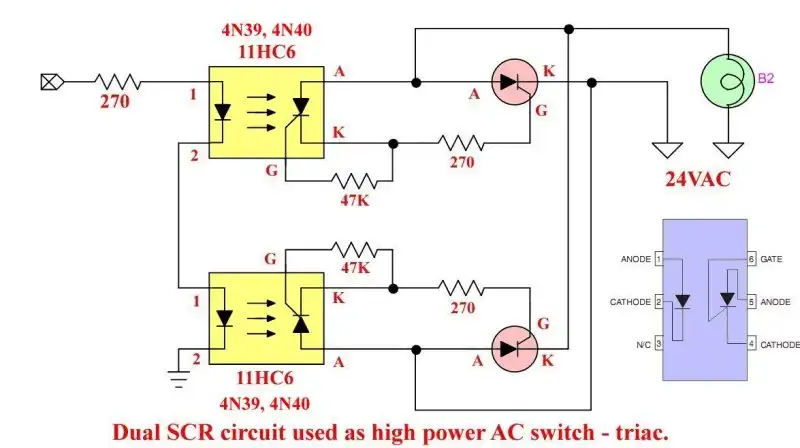
Fig. 5
I also built two separate SCR modules based on Fig. 3 with a single opto-coupler for each SCR. Here I used H11C6 photo SCR opto-couplers with input LEDs connected in series.
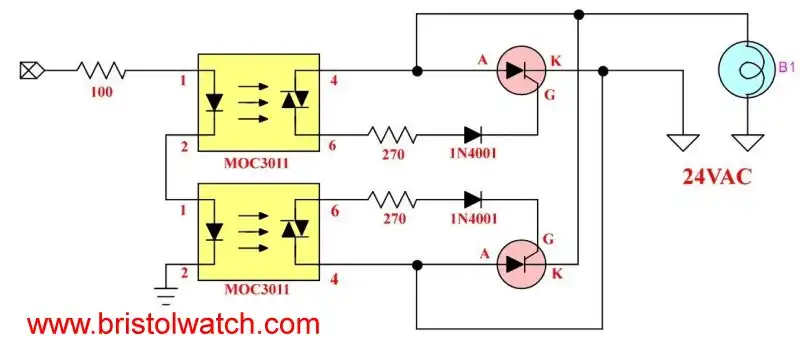
Fig. 6
Fig. 6 does the same thing as Fig. 5 but I use MOC3011 type opto-couplers with the additional gate diode.
- Exploring Solid State Relays and Control Circuits
- Comparing Photo Triac, Photo SCR Opto-Couplers
- Light Activated SCR Based Optocouplers Circuit Examples
- Silicon Controlled Rectifier Review and Circuits
- Silicon Controlled Rectifiers Connected as Power Triacs
- Insulated Gate Bipolar Transistor IGBT Circuits
- Current Limiter Circuits for Opto-Coupler LEDs
- VOM1271 Photovoltaic MOSFET Driver Circuits
- Current Limiter Allows Safe Testing of Zener Diodes, LEDs
- 3 Amp LM741 Op-Amp Constant Current Source
- Bidirectional Solid State Relay Circuits
- Simple Solid State Relay for Low Power LED 120V Lamps
- Build High Power MOSFET Directional Switch Relay
- Optical Isolation of H-Bridge Motor Controls
- All NPN Transistor H-Bridge Motor Control
- Basic Transistor Driver Circuits for Micro-Controllers
- ULN2003A Darlington Transistor Array with Circuit Examples
- Tutorial Using TIP120 and TIP125 Power Darlington Transistors
- Driving 2N3055-MJ2955 Power Transistors with Darlington Transistors
- Understanding Bipolar Transistor Switches
- N-Channel Power MOSFET Switching Tutorial
- P-Channel Power MOSFET Switch Tutorial
- Build a Transistor H-Bridge Motor Control
- H-Bridge Motor Control with Power MOSFETS
- More Power MOSFET H-Bridge Circuit Examples
- Build a High Power Transistor H-Bridge Motor Control
- H-Bridge Motor Control with Power MOSFETS Updated
- Opto-Isolated Transistor Drivers for Micro-Controllers
- Comparator Theory Circuits Tutorial
- Constant Current Circuits with the LM334
- LM334 CCS Circuits with Thermistors, Photocells
- LM317 Constant Current Source Circuits
- TA8050P H-Bridge Motor Control
- All NPN Transistor H-Bridge Motor Control
- Basic Triacs and SCRs
- Comparator Hysteresis and Schmitt Triggers
- Comparator Theory Circuits Tutorial
- Photodiode Circuits Operation and Uses
- Optocoupler MOSFET DC Relays Using Photovoltaic drivers
- Connecting Crydom MOSFET Solid State Relays
- Photodiode Op-Amp Circuits Tutorial
- Optocoupler Input Circuits for PLC
- H11L1, 6N137A, FED8183, TLP2662 Digital Output Optocouplers
- Optical Isolation of H-Bridge Motor Controls
- All NPN Transistor H-Bridge Motor Control
© Copyright 2019 Lewis Loflin E-Mail